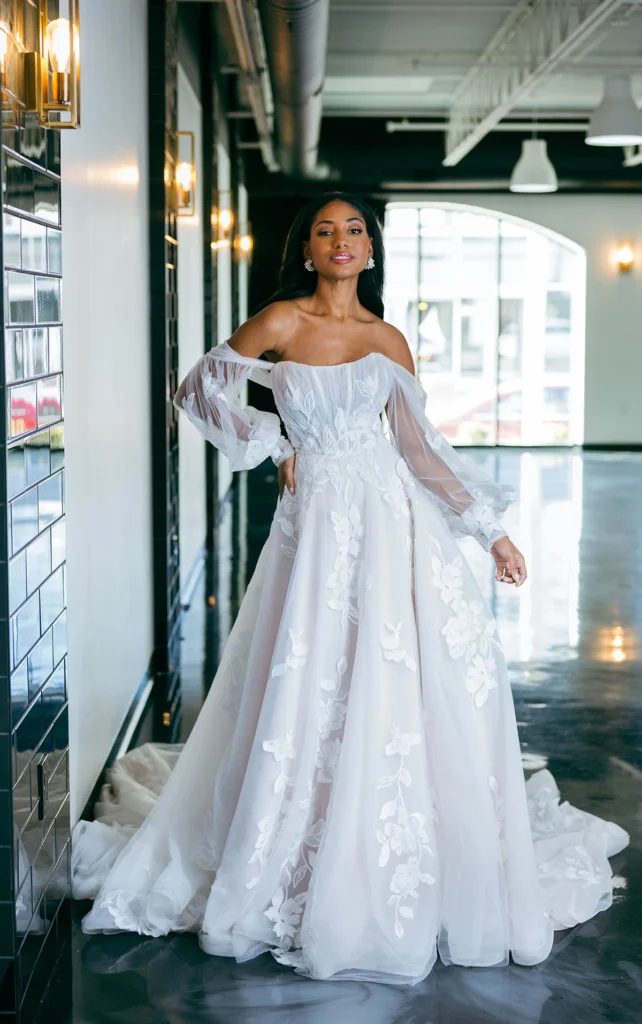A wedding dress is one of the most iconic garments a person will wear in their lifetime. Over the centuries, wedding dress styles have evolved, influenced by cultural trends, societal norms, and even historical events. From regal gowns of the past to today’s contemporary designs, let’s take a journey through time to explore how wedding dresses have transformed.

Medieval and Renaissance Eras (12th-16th Century)
During the medieval and Renaissance periods, brides wore elaborate dresses made from luxurious fabrics such as silk, velvet, and fur. Wealthy brides often adorned themselves in deep, rich colors like red, blue, and gold, signifying prosperity and status. These gowns featured long sleeves, intricate embroidery, and heavy brocade patterns. White wedding dresses were not yet the norm; instead, brides aimed to showcase their family’s wealth and social standing through their attire.
The 18th and 19th Century: The Rise of White Dresses
The concept of the white wedding dress became popular in 1840 when Queen Victoria wore an elegant white gown for her wedding to Prince Albert. This set a lasting trend, as white became associated with purity and innocence. Dresses of the Victorian era featured corseted bodices, full skirts with layers of petticoats, and detailed lace embellishments. Brides often accessorised with long veils and gloves, completing a look of refinement and elegance.
The Roaring Twenties: Flapper Influence (1920s)
The 1920s ushered in a dramatic shift in wedding fashion, mirroring the social changes of the time. Brides embraced the flapper style, favoring loose-fitting dresses with dropped waists, beaded embellishments, and shorter hemlines. Veils were often worn as headpieces adorned with pearls and feathers. This era reflected a newfound sense of freedom and rebellion against traditional constraints.
The 1950s: Hollywood Glamour and Cinched Waists
After World War II, wedding dresses took on a more feminine and glamorous look, heavily influenced by Hollywood icons like Grace Kelly and Audrey Hepburn. Dresses featured cinched waists, full skirts, and delicate lace detailing. Many brides opted for tea-length gowns, and veils became voluminous and dramatic. This era defined the classic, fairy-tale bridal look that remains popular today.
The 1970s: Bohemian and Free-Spirited Styles
The 1970s introduced a relaxed and bohemian approach to wedding fashion. Flowing fabrics, high-necklines, empire waists, and lace sleeves were all the rage. Inspired by the hippie movement, many brides chose simple, ethereal dresses, sometimes even foregoing veils in favor of flower crowns. The focus was on natural beauty and effortless elegance.
The 1980s: Bigger, Bolder, and More Dramatic
Wedding dresses in the 1980s were all about grandeur. Thanks to Princess Diana’s iconic wedding gown in 1981, with its enormous puffed sleeves, extravagant train, and voluminous skirt, many brides sought out dramatic, over-the-top designs. Satin, tulle, lace, and oversized bows dominated bridal fashion, making a bold statement with every step down the aisle.
The 1990s and Early 2000s: Sleek and Minimalist
As the 1990s arrived, wedding dress styles shifted towards sleek and minimalist silhouettes. Inspired by designers like Vera Wang, many brides opted for simple, elegant gowns with clean lines, strapless bodices, and minimal embellishments. The early 2000s continued this trend, with fitted mermaid and A-line dresses becoming increasingly popular.
Modern Trends: A Blend of Classic and Contemporary
Today’s wedding dresses embrace a fusion of past and present styles. Brides have the freedom to choose from a vast array of silhouettes, from traditional ball gowns to modern jumpsuits and two-piece sets. Lace remains a timeless favorite, while unique elements such as illusion necklines, open backs, and intricate beadwork have gained popularity. Sustainability is also playing a role in bridal fashion, with many designers offering eco-friendly fabrics and vintage-inspired dresses.
Wedding Dresses: Final thought
The evolution of wedding dresses reflects the ever-changing landscape of fashion, culture, and societal norms. From elaborate medieval gowns to minimalist modern designs, bridal fashion continues to adapt to the desires of each generation. Whether traditional or unconventional, the perfect wedding dress is ultimately a reflection of a bride’s personal style and the era in which she weds.

Leave a Reply